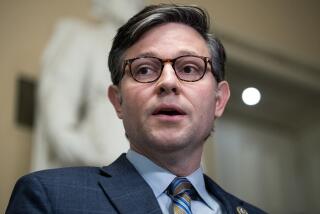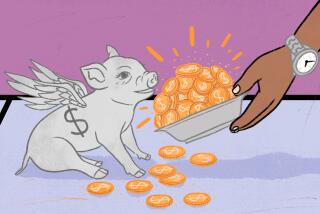Study Links Declining U.S. Savings Rate to Spend-Happy Seniors
- Share via
For some time, the mantra has gone something like this: A declining savings rate has led to declining investment, and declining investment has led to slow erosion in the average American’s standard of living.
But what accounts for this declining savings rate? It has fallen from more than 11% of household income in the 1950s and ‘60s to less than 4% in the 1990s.
During the 1980s, one favorite explanation was that profligate baby boomers were spending on BMWs, expensive suits and high-priced houses rather than stashing some away for their retirement and the kids’ education.
But a controversial new study concludes it’s really grandma and grandpa who’ve been living high on the hog.
In 1960, the typical 70-year-old American spent about 71 cents for every dollar spent by a 30-year-old, according to the study by Laurence Kotlikoff of Boston University, John Sabelhaus of the Congressional Budget Office and Jagadeesh Gokhale of the Federal Reserve Bank of Cleveland.
But by the late 1980s, it was the oldster who was the bigger spender, shelling out $1.18 for every dollar spent by the typical 30-year-old.
One obvious reason for this shift was the dramatic increase in health-care spending, particularly by the elderly, which followed the introduction of lots of expensive medical technologies. But even with medical costs factored out, the analysts still found seniors have been on a spending spree these past 30 years.
So what’s going on?
Slicing and dicing their data, Gokhale, Kotlikoff and Sabelhaus ruled out several plausible explanations for the declining savings rate, such as population shifts, an increase in the federal budget deficit and even a change in the general attitude of Americans toward savings.
In the end, they concluded the elderly have been garnering an ever-increasing share of the nation’s resources and have been spending that increase rather than saving it.
The transfer of wealth and income from young to old--what economists call intergenerational transfers--has been well-documented by Kotlikoff and others. The primary factors there are Social Security and Medicare benefits, the value of which have been rising faster than the incomes of working Americans.
But in this study, published by the Brookings Institution, Kotlikoff and his colleagues argue it is not simply the amount of national income seniors get, but the type of income, which particularly discourages them from saving as much as they used to.
In a world where people receive entitlements that last as long as they live, they are more likely to spend down their savings knowing they can always fall back on annuities if they live longer than average and draw down their entire savings.
By contrast, in a world without annuities, people are more likely to restrain their lifestyles and build up savings out of fear that they might outlive their savings.
Of course, Social Security, Medicare and private pensions have been around for a long time. But whereas these annuities represented 16% of income received by the elderly in 1960, they represent 40% of the income received by the elderly today. And it is this shift, according to Gokhale, Kotlikoff and Sabelhaus, that has led middle- and upper-income retirees to put less of their resources into the bank and spend relatively more on retirement homes, vacations, restaurant meals and gifts for the grandchildren.
In some respects, one could view all this as a positive development. One of the achievements of government policy of the last 30 years has been to lift millions of elderly citizens above the poverty line and ensure they have a measure of comfort, security and dignity in their old age.
But Kotlikoff argues intergenerational transfer represented by Social Security and Medicare “has now gone way beyond what could be rationalized as an anti-poverty program. What we are dealing with now is the expropriation of billions of dollars every year from young workers to finance the ever-rising consumption by greedy geezers.”
There are, however, three other conclusions possible.
* Spending on medical care has had the effect of making seniors more fit--and thus more able to take a vacation or swing a golf club. In this view, it is the opportunity--not the inclination to consume--that has changed.
* With fewer seniors living under the same roofs as their children and grandchildren, it’s only reasonable to expect them to spend more.
* It may not be the low savings rates of today that are the anomaly, but the unusually high savings rates of the 1950s and ‘60s, when many seniors had keen memories of the Great Depression.
Whatever the case, the debate over the savings rate is likely to get shriller as Washington turns its attention next year to restoring the Social Security system to fiscal health.
More to Read
Inside the business of entertainment
The Wide Shot brings you news, analysis and insights on everything from streaming wars to production — and what it all means for the future.
You may occasionally receive promotional content from the Los Angeles Times.










